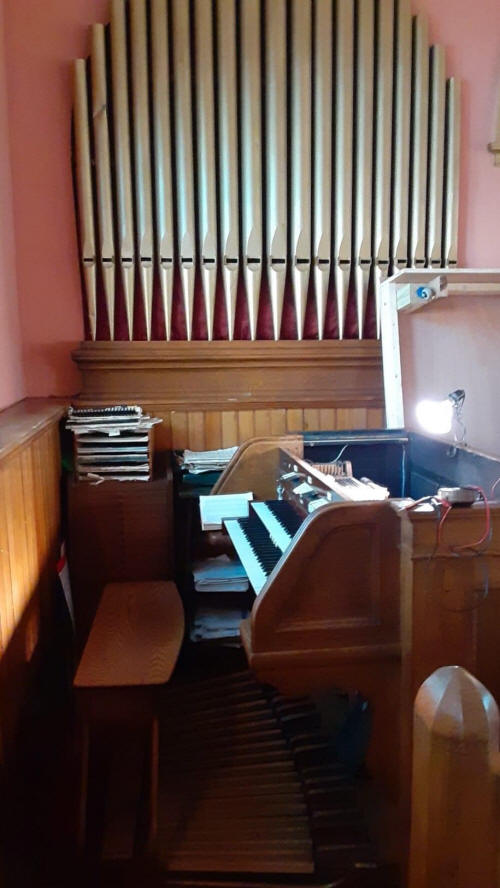|
Builder: Hall Organ Co, 1919 Manuals: 2 Ranks: 11 Stops: 11 Action: Electro-pneumatic Notes: In 1918 Jessie and Lucius Pond Ordway moved to 400 Summit Ave, a 3-story house built in 1882 for Maurice and Matilda Rice Auerbach. It was remodeled extensively in the 1920's when the "pipe organ and the entire attic was filled with pipes". Jessie played the instrument for a short time, but the organ eventually went to the Swedenborgian Church on irginia St. in St. Paul. The article relating the story can be found under "The Financial Angel Who Rescued 3M" (Ramsy County History newsletter, Fall 2001 issue). -- Information from Grandall & Engen, 2016 and Jayson Engquist, 2020 -- Second photo by Ed Copeland, 10/2020 GREAT 8' Open Diapason 8' Gross Flute 8' Gedeckt 8' Dulciana 16, 8, 4 Swell to Great 4' Great to Great SWELL 8' Gedeckt 8' Viole d'Orchestre 8' Viole Celeste 8' Aeoline 8' Unda Maris 4' Flute Harmonic Tremolo 16' , UO, 4 Swell to Swell PEDAL 16' Bourdon 16' Lieblich Gedeckt 8' Great to Pedal 8' Swell to Pedal 4' Swell to Pedal |
 |
 |
|
|
|
 |
|
|
 |
 |
|
|
The New Church (or Swedenborgianism) is the name for several
historically related Christian denominations that developed as a new
religious movement, informed by the writings of Swedish scientist
and theologian Emanuel Swedenborg (1688–1772). Swedenborg claimed to
have received a new revelation from Jesus Christ through continuous
heavenly visions which he experienced over a period of at least
twenty-five years. In his writings, he predicted that God would
replace the traditional Christian Church, establishing a 'New
Church', which would worship God in one person: Jesus Christ. The
New Church doctrine is that each person must actively cooperate in
repentance, reformation, and regeneration of one's life.[1] The
movement was founded on the belief that God explained the spiritual
meaning of the Scriptures to Swedenborg as a means of revealing the
truth of the Second Coming of Jesus Christ. Swedenborg claimed
divine inspiration for his writings[2] and followers believe that
Swedenborg witnessed the Last Judgment in the spiritual world, along
with the inauguration of the New Church. The New Church is seen by members of New Church organizations as something which the Lord is establishing with all those who believe that the Lord Jesus Christ is the one God of heaven and Earth, and that obeying his commandments is necessary for salvation. Therefore, it is thought that any Christian holding these beliefs is part of this New Church movement. New Church organizations also acknowledge the universal nature of the Lord's church: all who do good from the truth of their religion will be accepted by the Lord into heaven, as God is goodness itself, and doing good conjoins one to God.[3] Adherents believe that the doctrine of the New Church is derived from scripture and provides the benefit of further enlightenment concerning the truth, and that this leads to diminished doubt, a recognition of personal faults, and thus a more directed and happier life.[4] Other names for the movement include Swedenborgian, New Christians, Neo-Christians, Church of the New Jerusalem, and The Lord's New Church. Those outside the church may refer to the movement as Swedenborgianism; however, some adherents seek to distance themselves from this title, since it implies a following of Swedenborg rather than Jesus Christ. Swedenborg published some of his theological works anonymously, and his writings promoted one Church based on love and charity, rather than multiple churches named after their founders based on belief or doctrine.[5] (Wikipedia) |
|